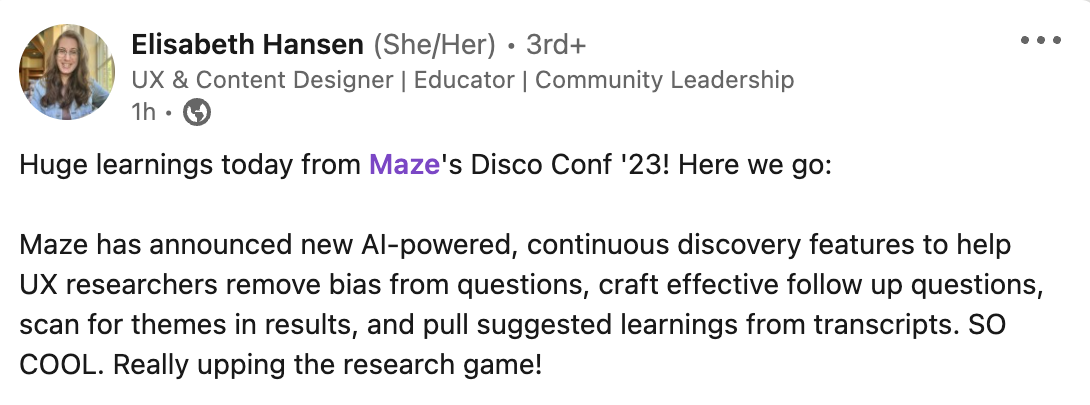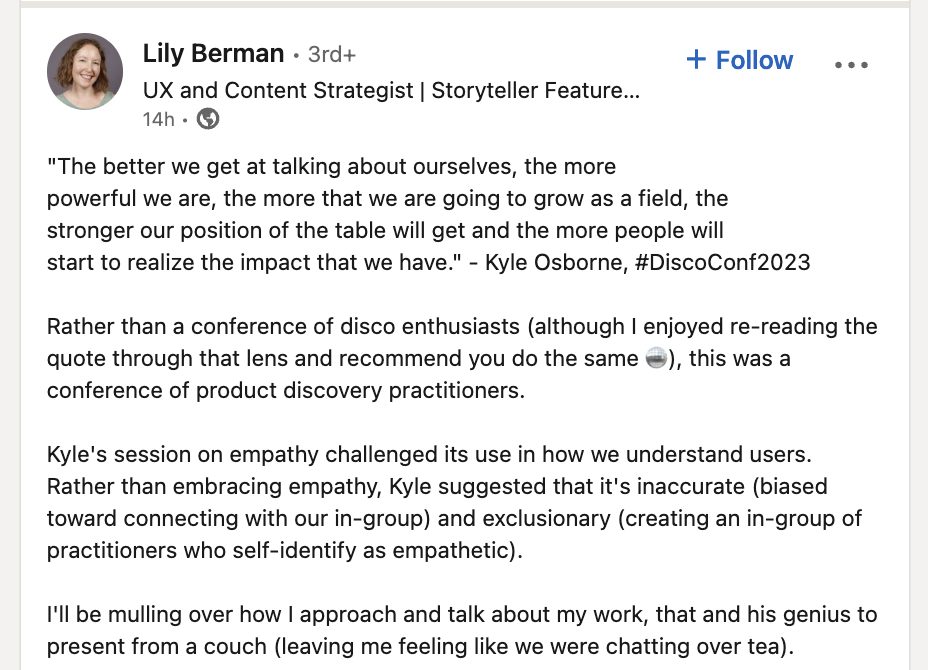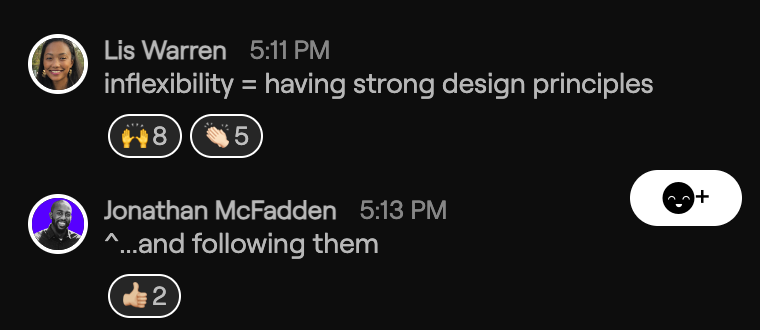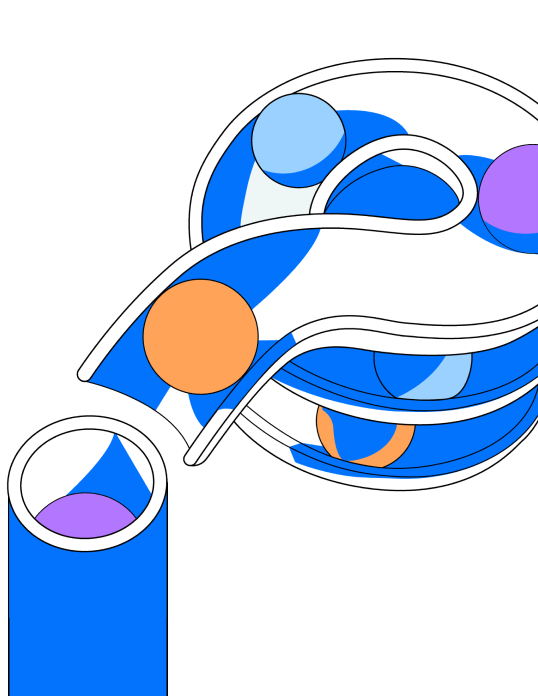On September 19, over 14,000 product professionals from around the world tuned in to hear from discovery, design, and research experts speaking at Disco Conf.
Driven by a taste for curiosity, we dove into an amazing day of over 20 thought-provoking sessions.
If you didn’t have time to tune in, or felt a little mind-blown by all the conversations, we’ve put together this handy rundown of the key takeaways you need to know from the industry's favorite UX research conference: Disco Conf '23. You can also watch all Disco Conf '23 sessions for yourself on-demand.
AI: the new research companion
The topic on everyone’s mind? It’s AI.
We would have been remiss to talk about the current and future state of research, design, and discovery without mentioning AI.
A recurring throughline of conversations during the day, AI had its biggest moment at Disco Conf ‘23 in the Maze product update where we announced a groundbreaking suite of AI-powered features to help product teams to scale research and rapidly make user-informed decisions.
Director of Product at Maze, Netali Jakubovitz led us through a demo of 10+ new features including Dynamic Follow-Up, Smart Renaming, and Interview Studies, product teams can use AI to:
- Ask personalized follow-up questions informed by participant answers
- Detect bias or illegibility in questions and suggest new phrasing
- Automate maze naming with smart, contextual suggestions
- Summarize and analyze moderated research recordings
- Extract key messages and identify sentiment in interview recordings

Leading on from our product update was Linus Lee’s session on building with AI, for humans.
As a Research Engineer at Notion, Linus discussed the importance of managing user expectations, building trust with your customer, and working with technology as a tool, rather than the whole solution.
Echoing Maze CEO & Co-founder, Jo Widawski’s vision on AI at Maze, was the recurrent sentiment of using AI and emerging technology to expedite product development and discovery.
As Jo says, “AI is poised to shift how fast and how often we get access to user insights, but it’s not changing the indisputable value of research: an intimate understanding of users and their needs.”
In his story of how Notion came to work with AI, Linus emphasized the potential of generative AI: “It’s a very flexible and very adaptable [interface]. You can ask the AI for anything.” The potential for how AI can improve workflows, answer questions, and support product teams seems endless. But the pros of AI aren’t just in what it can do, but in who can use it.
“We’ve learned a lot about how people use AI features, and how to design with this new stochastic, generative, really powerful technology.”

Linus Lee
Research Engineer at Notion
Share
Linus shared how AI offers an accessible way of performing tasks, whether that’s processing data, generating ideas, or extracting information. “[AI] is quite technically simple to implement… The chat interfaces are easy to use, as most people know how to use a messaging app. So users pretty quickly get the hang of the mechanics.” Anyone with basic knowledge of search engines or word processors can pick up an AI-powered tool, and use it to speed up their processes or craft a perfect research question. In this sense, AI is a companion to democratizing research and improving accessibility across products.
In our closing keynote, Jo and Behzod Sirjani, Founder at Yet Another Studio, continued the conversation on trust and AI, shifting to the perspective of product teams.
Jo explained that by supporting and streamlining the entire research process, from data collection to analysis, AI will in fact make research more important than ever: “AI is going to level the playing field in product development. All of a sudden any company has the capacity to build products. And so in a world that doesn't have the constraint on how fast you can build stuff, all of a sudden it changes the way that we approach research.”
It's very exciting because it puts research at the center of the organization, by default and by design. To build the right thing, research is the power behind this.

Jo Widawski
CEO & Co-founder at Maze
Share
Behzod and Jo reflected on how, in this new landscape, it’s far more about building the right product first (time-to-right), rather than simply building a product fastest (time-to-market). Jo shared that Maze is trying to power a future where research can happen at the speed of product development.
It is here that AI tools come in—by scaling and expediting learnings; working in collaboration with researchers, not against them.
Takeaway: Artificial intelligence isn’t going anywhere, and the successes of this era will be those who integrate AI into their product development workflows. AI is about accelerating learnings and facilitating growth for and with humans.
💡 Learn more about how you can use Maze’s new AI features to harness the voice of the user at scale.
Maximizing the reach of research
The next key theme in conversation at Disco Conf ‘23 was that of democratization. Whether you consider democratization a buzzword or a driving force in your organization, the consensus among attendees and speakers alike was that democratization of research is still relevant, and needed.
Part philosophical thought experiment and part tactical advice, Aiden Hirschfield’s presentation was an audience favorite, beautifully illustrating the importance of everyone being involved in research—and thus, escaping ‘research island’. From critical conversations about right-sizing your research effort, to being human-centered, and recognizing the different expertise of ‘Capital R’ researchers, Aiden’s session set the stage for a day-long discussion on how best to leverage resources, scale research, and democratize learning.
Another insightful case study came from Christopher Nash, recounting his experience scaling research teams at Airtable and Dropbox, Nash highlighted how democratization and scaling research is often misunderstood as the notion of giving free research reign to all employees.
Democratization is not research anarchy. Democratization is about creating and nurturing a culture of learning at your company.

Christopher Nash
UX Research Democratization Specialist
Share
And as Renu Zunjarwad, Senior UX Researcher at Truckstop, said in her presentation, "To drive impact we don't need to transform non-researchers into research experts. Instead, the focus must be on empowering them with knowledge and skills to do certain types of research confidently and independently."
Just as AI will not replace human researchers any time soon, neither will empowering product teams to upskill, and embark on their own research projects. Sara Gallant and Hayley Evans, Design Research Leads at League, also shared how they’ve built a democratization strategy from the ground up, with built-in guardrails that maintain the integrity of research while optimizing and scaling its function.
Sara commented that ��“Democratizing research is not just talking about letting everyone do research, but rather about making it possible and accessible for non-researchers to do user research by providing them with the appropriate training tools and some boundaries to make sure everything stays on track.”
This approach, according to Renu, promotes a responsible user experience research practice mindset, driving a multifaceted impact for both the product and the business, through education, knowledge, and empowerment.
Nash also commented on the importance of guidance for success: "Responsible democratization requires a well-resourced and intentional program that provides guidance, guardrails, and oversight."
Summarizing the success many of our speakers have seen with democratizing research, Hayley explained: "When democratized well and responsibly, democratization can actually help to scale the impact of user research and accelerate product teams’ ability to make user-centered decisions during development."
Takeaway: Democratization within a structured framework is an opportunity for improved research capacity, more user-centered insights, and better collaboration and cross-functional cohesion.
Accessibility is more important than ever
Meanwhile, on our methods content track, two DE&I experts joined us for timely conversations on accessibility and inclusion.
Anna Cook, Senior Inclusive Designer at Microsoft, shared her insights on how to build an accessibility initiative that builds momentum. One common theme throughout these talks was the myth that making products accessible only benefits those with disabilities.
The power of inclusive and accessible design is that what we learn from disabled users extends and creates increased usability for everyone.

Anna Cook
Senior Inclusive Designer at Microsoft
Share
Later, Lanre Jerry-Ijishakin, User Experience Researcher at Emids, echoed this sentiment in her session on building inclusive products through research. Lanre highlighted that one of the huge benefits of inclusive design is that it drives innovation. From audiobooks to voice memos, features originally designed for accessibility have come to benefit everyone.
Some key tips from Lanre and Anna were to:
- Include accessibility principles in your design system
- Use accessibility and UX audits to review current designs
- Include people with disabilities in your UX research
- Use accessibility principles when conducting heuristic evaluation
- Start by gaining leadership buy in, then work your way down
- Remember that accessibility and inclusion initiatives are not a linear journey
Takeaway: Accessibility helps you create a better product, not just a better experience. While focus on accessibility and inclusivity requires purposeful work and effort, the successes of accessible design benefit everyone.
Foster creativity, and think abstractly
Across keynotes and content tracks alike, Disco Conf ‘23 laid the foundation for conversations on self improvement, discovery, professional development, inspiration, and creativity. Ideas such as thinking ‘outside the box’ and pushing beyond your comfort zone wove through multiple presentations.
First up, Kyle Osborne, Design Researcher at Royal Bank of Canada, led the audience through a discussion on empathy—from labeling designers as ‘empaths’ and anchoring the design discipline in empathy, to how to shed this label (and whether we should), Kyle self-proclaimed the topic to be “a little controversial, a little uncomfortable, and a little touchy”. But our audience loved it.

Sparking heartfelt debates on what it means to be user-centered in design, conversations around empathy and questioning the status quo emerged in later sessions, too.
Sharanya Ravichandran, VP Design at JPMorgan Chase, presented a session on how design can be a superpower in the future of banking—discussing how financial services need to get on board with user-centered design or risk being left behind.
Christina Goldschmidt, VP of Design at Warner Music Group, ran a workshop on looking beyond your usual sphere for inspiration, and turning to spiritual practices like tarot and breathwork, when faced with decision-making in uncertain times.
Meanwhile, Jonathan McFadden, Senior Content Designer at Shopify, explored the importance of being inflexible when necessary, in order to advocate for user-centric decisions in product design. He emphasized that being inflexible doesn’t mean you are stubborn, but rather “a style of working in which you refuse to budge when it matters most. When you stand up for users who are unable to stand up for themselves.”
Jonathan commented on the unique role designers have in advocating for users, encouraging attendees to ‘own their space’ and remember their value. He noted that inflexibility is a critical component of design work and can lead to better conversations, visibility, and products—but that it requires personal risk analysis, strategy and tact, and data-backed arguments.

The conversation didn’t end there. In the second half of Disco Conf ‘23, we moved to the practical side of the tracks—talking upskilling, evolution of roles, and self-improvement.
Lauren Stern, Director of Global Insights at iRobot, led us through how to create unique discovery workshops, with a particular emphasis on bringing play and creativity into the product development process.
From human-robot improv workshops, to using arts-and-craft to ‘see’ data, Lauren shared: “Ultimately, I really believe technology is better when we get creative. The more we think about humans and their social interactions and how we develop autonomous experiences, the better our future technologies will be.”
Lauren encouraged attendees to let go of practical or technological elements when doing product discovery: “It's very easy when we're focused on product development to get caught up in constraints, restrictions and technological feasibility of what we're talking about. But when we're early in the process thinking about discovery here, we don't want to do that.”
We want to really think big. We want to set a North Star. And the easiest way to do this is to just not talk about technology. We're not gonna worry about it. It'll come back in later.

Lauren Stern
Director of Global Insights at iRobot
Share
Letting go of the practical and logical constraints of product development was also emphasized by Zoë Glas, Senior UX Researcher at Google, who joined us to talk about how wildlife management can positively impact your UX (yes, you read that right).

In her intriguing session, Zoë discussed how leaders can borrow from ecosystem management principles to reevaluate how research can be conducted and strategies can be driven forward. Comparing the UX community and UX team structure to an ecosystem, Zoë proposed a new framework for prioritization, collaboration, and growth.
Above all, Disco Conf ‘23’s presentations emphasized driving progress through creativity, taking inspiration from unusual places, and being confident in curiosity.
Takeaway: Don’t be afraid to question the status quo and hold your ground. Borrow ideas and inspiration from outside your normal sphere, then apply it to your field. Sometimes the best ideas or approaches are taken from unexpected places.
Mixed methods are the way forward
Marrying the creativity of some talks with the practical advice of other sessions was our dedicated research methods content track. From usability testing to user interviews, we journeyed through quantitative and qualitative methods, hearing new approaches and perspectives across the board.
We learned how to integrate rapid research frameworks—and when to avoid them—with Christa Simon, Rapid Research Manager at Figma, who shared: “The biggest thing to remember when deciding to use rapid research or not is considering the type of insight you'll get back, based on your research questions: it should add focus and scope, providing you with an exact direction, versus leading your team to ask even more questions.”
Brent Palmer, Product Design Manager at Mixpanel, shared how to level up your UI design and scale with concept testing. Brent suggests using tools like Maze “to bring insights into the entire process, which helps us beat that trade-off [between speed and quality]” to maintain a high-quality bar while avoiding potential pitfalls.
Meanwhile, Product Management Coach, Tim Herbig, talked us through turning product discovery into product decisions, demonstrating how product teams can gather evidence to reduce uncertainty and continuously make stronger research-driven decisions.
Discovery is really about the evidence-informed reduction of uncertainty around the problem we're solving, and finding a solution worth building.

Tim Herbig
Product Management Coach
Share
Workshops re-emerged as a creative technique to build impactful products, with Paige Bennett, Lead User Researcher at Affirm, discussing how this technique is “a secret tool in your research and design toolbox”. Paige explored how workshops can be used across each step of product development to meet both user and business needs. She noted how they allow teams to identify gaps in your product or knowledge, help prioritize resourcing, and align team members on actions and goals.
Ultimately, whether you’re embarking on a rapid research sprint, concept testing, or product discovery sessions and workshops, there’s a wealth of unique research methods available to product teams and researchers. It’s all about knowing how to use them.
Takeaway: Effective research and decision-making requires efficient frameworks, reliable tools, and a good dose of creativity.
Research maturity is a marathon, not a sprint
Rounding off our day, Vanessa Arango, Director of UX Research at Delivery Hero, delved into her experience growing the research function at multiple organizations, and key considerations when looking at research maturity.
The biggest takeaway from Vanessa was understanding the current state of your organization, in order to define its future path: “I do believe it’s important to think about the context of the business you work in, in order to create a more consistent and realistic plan to continue [research] progression.”
Highlighting the need for specific methods, tools, frameworks and processes to grow the research discipline within your organization, Vanessa’s session led perfectly into our first closing keynote: Dalia El-Shimy’s discussion on Maze’s Research Maturity Model.
Dalia, Head of UX Research at Miro, shone a light on research maturity models and how to level up your organization’s research maturity.
The idea behind maturity models is that they can spark discussion and empower organizations to assess themselves.

Dalia El-Shimy
Head of UX Research at Miro
Share
Vanessa suggested focusing on five key areas: people, processes, practice quality, alignment and collaboration, strategy and contribution. Meanwhile, Dalia shared a behind-the-scenes look at the three key areas of Maze’s Research Maturity Model: people, processes, and impact.
The Research Maturity Model offers a way to assess your organization’s current maturity, identify the next level, and what steps to take to achieve this progression.
Dalia summarized: “It can inspire organizations by showing them what additional levels of maturity lay ahead; they can help offer concrete plans for how to reach those higher levels of maturity, which in turn makes it easier for teams to understand how to advocate for resources—and through all this, to be able to actually go to higher levels of maturity.”
With discussions on AI, researcher lay-offs, and an ever-changing landscape leading Disco Conf ‘23, Vanessa and Dalia’s presentations highlighted that for research functions to not only survive, but thrive, they must transition to become a strategic element of the business, and be purposeful in their progression and maturity.
Research is no longer a supporting function, it is a critical strategic role. In order to reach this place, and continue offering value, organizations’ research maturity must progress.
Takeaway: To mature their research function, organizations must evaluate their current offering—from where they focus resources, to the kind of research conducted. Researchers should consider maturity frameworks, and embrace their evolution into a strategic pillar of business.
Disco Conf ‘23 may be over, but the discovery is just starting
We had an amazing day at Disco Conf ‘23, with so many incredible speakers sharing their expertise and insights with our global community.
Common themes of working with AI instead of against it, embracing frameworks and structures for improved outcomes, scaling research through continuous learning, thinking outside the box and borrowing inspiration from unexpected places have left us with a lot to mull over.
Whether you joined us on the day or are catching up on-demand, there’s a wealth of knowledge and inspiration available.





